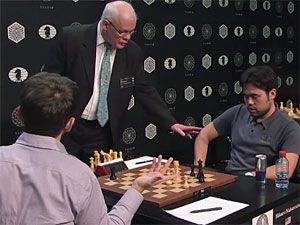


Winning starts with what you know
The new version 18 offers completely new possibilities for chess training and analysis: playing style analysis, search for strategic themes, access to 6 billion Lichess games, player preparation by matching Lichess games, download Chess.com games with built-in API, built-in cloud engine and much more.

The 2016 FIDE World Chess Candidates Tournament is a 14-round event, which determines the next Challenger to Magnus Carlsen's title, is taking place in Moscow from March 10–30. Eight players, including six of the World’s top-ten rated grandmasters. The time control is 100 minutes for the first 40 moves, 50 minutes for the next 20 moves and then 15 minutes for the rest of the game, plus an additional 30 seconds per move starting from move one. The guaranteed prize fund is US $420,000.
| Round 6, Thursday 17 March 2016 | ||
| Anand Viswanathan |
1-0
|
Svidler Peter |
| Topalov Veselin |
½-½
|
Giri Anish |
| Aronian Levon |
1-0
|
Nakamura Hikaru |
| Caruana Fabiano |
½-½
|
Karjakin Sergey |
|
Rest day, Friday 18 March 2016
|
||

Note that ChessBase is doing daily one-hour roundup shows after each round
It was by far the worst weather in Moscow since the tournament began. The skies were overcast and it was already snowing a bit. The players covered with thick layers of winter wear proceeded to the tournament hall. It’s a six minute walk from the official hotel Four Seasons to the venue in the Central Telegraph.
This video shows seven of the eight players (Peter Svidler missing) leaving the Hotel Four Seasons to go to the tournament hall. It also gives you a feel of what the hotel and the surroundings are and also how far the venue is from the official hotel.
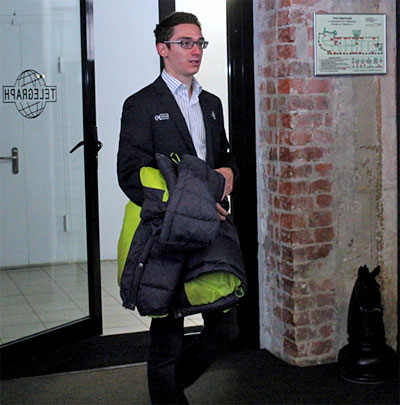
After his experiments with the Benoni yesterday,
Fabiano came well prepared for his game against Sergey Karjakin
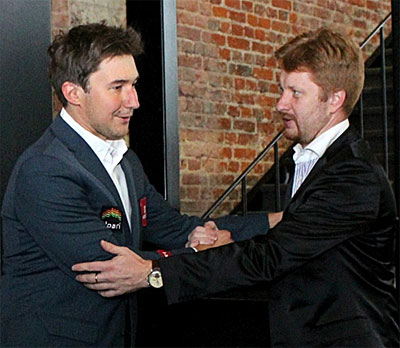
Sergey Karjakin received wishes from his second Vladimir Potkin before the game
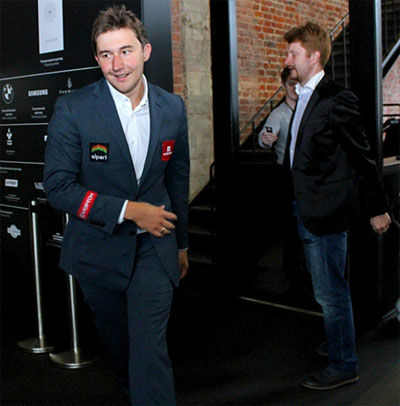
And off he went in an upbeat mood!

The nice thing about Levon Aronian is that he speaks in a
friendly manner with whoever meets him, even before the game

“Look at the amount of preparation youngsters have these days!”
Veselin Topalov and Silvio Danailov enter the playing hall with Peter Svidler
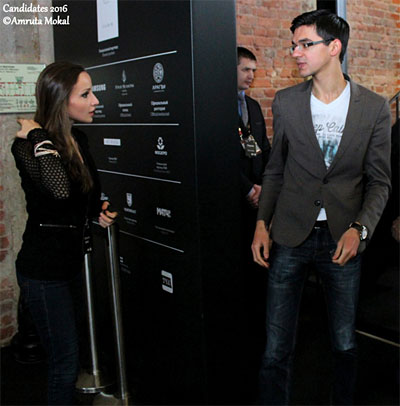
Did you revise 1.d4 Nf6 2.c4 g6 3.h4!? Sopiko and her husband Anish Giri
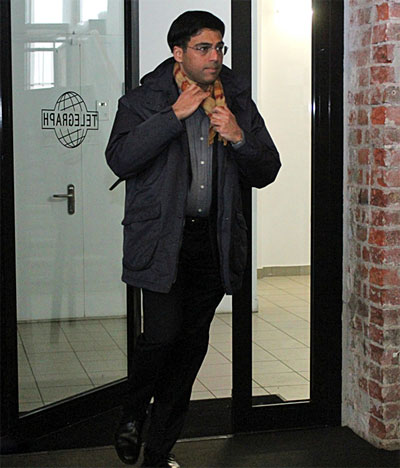
Anand came to the playing hall determined to do some damage!
The game of the day had to be Viswanathan Anand’s emphatic victory over Peter Svidler. It was ironical that Peter, who has shown excellent preparation at this event – blitzing 25 moves of theory against Nakamura, was mated by Anand in just 24 moves!

Vishy Anand and Peter Svidler have been friends off the board for close to two decades now.
Their first encounter with each other dates all the way back to 1998.
It is an open question as to what Anand would have done if Peter would have opted for the Berlin move order with 3…Nf6. But instead the Russian went for the main line of the Closed Ruy Lopez, clearly angling to play the Marshall. Anand put an end to these ambitions by playing a4, and here Peter sprung the first surprise of the game.

In all thirteen games that have reached the position after 8.a4 in Svidler’s praxis, he has gone 8…b4. Today was the first time he went 8…Bb7. No wonder, Anand was confused and took quite some time to make his moves from this point onwards. His play was natural in the style of the Ruy Lopez – developing the knight to d2, bishop came back to c2 and then going for the d4 push. Svidler could have surely played it much safer in the middlegame, but he took up the challenge and went for the following position.

To take or not to take, that is the question!
This was a critical position where Anand took quite some time. There are a lot of captures. As Anand correctly pointed out that the main question to him was whether to take on b5 or not. On one hand keeping the a-file closed keeps the rook on the back rank safeguarding it. On the other hand the a1-rook doesn't take part in the game. It is a very difficult decision to make and almost impossible to see what possibilities may arise after say eight to ten moves. But this is where intuition comes into the picture and Anand felt that bringing the a1 rook into the game was more important and that’s why he took on b5.
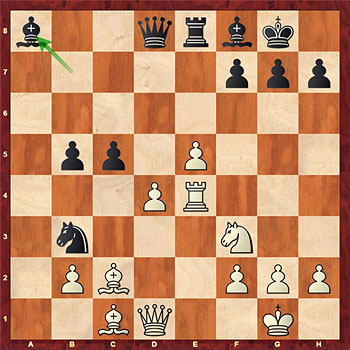
At this point I went to tournament hall to check out what exactly was going on. I expected Anand to be looking happy while Svidler would be at the board with his head in his hands. But the scene I saw was completely opposite. Peter had just captured the rook on a8 and was moving around confidently. Anand on the other hand was nervous, fidgety, biting his nails and looked as if he was the one on the back foot. But it was clear that Vishy was calculating the details of his final attack, anxious to make sure that his opponent had no defensive resources. And in the above position he picked up his knight and made the best move 20.Ng5!

As storm clouds gather around the black king Peter played his final trick: queen to a5. Anand immediately pushed his pawn to h4 – and Svidler resigned! Anand’s h4 looks like a normal move but the point is subtle. 24…Qe1+ 25.Kh2 Ne2 is met with the move 26.Nh3! and the g1 square is controlled. The same wouldn’t have been possible with the pawn on h3.

While Anand’s play was truly fantastic, one must give it to Svidler for being
such a sport and taking the defeat in a very graceful manner

[Event "Candidates 2016"] [Site "?"] [Date "2016.03.17"] [Round "6"] [White "Anand, Viswanathan"] [Black "Svidler, Peter"] [Result "1-0"] [ECO "C88"] [WhiteElo "2762"] [BlackElo "2757"] [Annotator "Sagar Shah"] [PlyCount "47"] {An emphatic victory for Anand. Let's have a look at the game to see what really went right for him and wrong for Svidler.} 1. e4 e5 2. Nf3 Nc6 3. Bb5 a6 4. Ba4 Nf6 5. O-O Be7 6. Re1 b5 7. Bb3 O-O 8. a4 ({The following game between Anand and Svidler with the inclusion of h3 and h6 is very similar to what we saw today. And Svidler played much better back then.} 8. h3 Bb7 9. d3 Re8 10. a4 h6 11. Nbd2 Bf8 12. c3 Na5 13. Bc2 c5 14. d4 cxd4 15. cxd4 exd4 16. e5 Nd5 17. Nxd4 Nb4 18. axb5 Nxc2 19. Qxc2 axb5 20. Nxb5 Qb6 $15 {1/2-1/2 (47) Anand, V (2779)-Svidler,P (2728) Morelia/Linares 2007}) 8... Bb7 {[%cal Gc8b7] Although this is the main move in the position, Anand thought for a good ten minutes. Why? Because Svidler has got the position 13 times in his games and all the times he has chosen b4.} (8... b4 {is Svidler's move.}) 9. d3 Re8 10. Nbd2 Bf8 11. c3 Na5 12. Bc2 c5 {This is all very standard Ruy Lopez stuff. Now White must remain consistent and break in the centre with d4.} 13. d4 exd4 { This came as a bit of a surprise to Anand. But Peter was mainly trying to play very concrete chess.} 14. cxd4 d5 $6 {Although this is very thematic. It is extremely dangerous. The main reason being that the two bishops on c1 and c2 are opened up against the black king.} (14... cxd4 {looks like the best way for Black to proceed.} 15. e5 Nd5 16. axb5 axb5 17. Nxd4 Nb4 18. Bb1 $13 { is an interesting game.}) 15. e5 Ne4 {This was a critical position where Anand took a lot of time. There are a lot of captures. As Anand correctly pointed out, the main question to him was whether to take on b5 or not. On one hand keeping the a-file closed keeps the rook on the back rank safeguarding it. On the other hand the rook doesn't take part in the game. It is a very difficult decision to make and almost impossible to see what possibilites may arise after say eight to ten moves. But this is where intuition comes into picture and Anand felt that bringing the a1 rook into the game was more important and that explains his next move.} 16. axb5 (16. Nxe4 dxe4 17. Rxe4 {Now this exchange sacrifice is not as effective as in the game.} (17. Bxe4 Bxe4 18. Rxe4 Qd5 $1 {Important to blockade the d-pawn before attacking it.} 19. Re3 (19. Qe2 Nb3 $17) 19... Nc6 $15) 17... Nb3 $1 18. Ng5 (18. Rh4 Bxf3 19. Bxh7+ Kh8 20. Rh3 Bxd1 21. Bg6+ $11 {All of these analyses lead us to the fact that Anand's decision of taking axb5 was better than not taking.}) 18... Nxa1 19. Qh5 Qxg5 $1 20. Bxg5 g6 (20... Nxc2 21. Rh4 h6 22. Bxh6 g6 23. Rg4 Nxd4 24. Rxg6+ fxg6 25. Qxg6+ Kh8 $11) 21. Qd1 Nxc2 22. Qxc2 Bxe4 23. Qxe4 cxd4 $15 {Only Black can be better here.}) 16... axb5 (16... Nxd2 $2 17. Bxd2 axb5 18. Bxh7+ $1 { wins! It's a standard Greek Gift!} Kxh7 19. Ng5+ Kg8 (19... Kg6 20. Qg4 $18) 20. Qh5 $18) (16... cxd4 $6 17. bxa6 Rxa6 18. Nxe4 dxe4 19. Bxe4 Bxe4 20. Rxe4 Bc5 21. b4 $1 Bxb4 22. Rxd4 Qb8 23. Qd3 $18) 17. Nxe4 dxe4 18. Rxe4 $1 { This move might be natural for a player like Anand, but for us who are taught about the relative value of the pieces since a young age, it is not easy to consider a such a move. Once you see it, though, and you realize that the bishop on e4 will be a complete monster, breathing fire in both directions, you make this move!} (18. Bxe4 Bxe4 19. Rxe4 Qd5 $11 {gives Black excellent chances to hold.}) 18... Nb3 (18... Bxe4 19. Bxe4 {[%cal Ge4a8,Ge4h7]} Ra7 ( 19... Rb8 20. Bxh7+ Kxh7 21. Ng5+ Kg8 22. Qh5 $18) (19... g6 20. Bxa8 Qxa8 21. Bd2 b4 22. Qa4 $18) 20. Bxh7+ Kxh7 21. Ng5+ $18) 19. Rxa8 Bxa8 {[%cal Gb7a8] At this point I went to tournament hall to check out what exactly was going on. I expected Anand to be looking happy while Svidler would be on the board with his head in his hands. But the scene I saw was completely opposite. Peter had just captured the rook on a8 and was moving around confidently. Anand on the other hand was nervous, fidgety, biting his nails and looked as if he was the one on the back foot. But it was clear that Vishy was calculating the details of his final attack, anxious to make sure that his opponent had no defensive resources. And in the above position he picked up his knight and made the best move 20.Ng5!} 20. Ng5 $1 {Svidler came back and saw this move. I thought that the Russian would think for a while before he would make his move but he blitzed it out. He was showing that he had it under control.} (20. Rh4 Bxf3 21. Bxh7+ Kh8 22. Rh3 Bxd1 23. Bg6+) 20... Nxc1 21. Qh5 $1 {[%csl Rf7,Rh7] Once again the only move. There is an attack on both the h7 and f7 pawns.} h6 { This move was also made quickly.} (21... Qxg5 {was a way to avoid an immediate defeat, but doesn't really serve any purpose as after} 22. Qxg5 Bxe4 23. Qxc1 $1 Bxc2 24. Qxc2 $18 {the position is technically winning. It won't be so difficult for a player of Anand's calibre to turn this into a win.}) (21... Bxe4 22. Bxe4 h6 23. Qxf7+ Kh8 24. Qg6 $18) 22. Qxf7+ Kh8 {At this point Peter once again stood up from the board and started walking around. Anand was making his final calculations, the other players were all coming to the board and making faces of disbelief. Nakamura stood right next to Svidler's seat for almost a minute. He just didn't want to leave. He checked the scoresheet, then the board and couldn't believe that Anand was just winning. He went back to his board, Anand lifted his hand and once again made the only winning move in the position.} 23. Rg4 $1 {The rook defends the knight and now the threat is Qg6. Black doesn't really have a way to stop the attack.} (23. Rf4 Ne2+ $19) 23... Qa5 {And once again Anand has the only move to win.} (23... Ne2+ 24. Kf1 $1 {wins!} (24. Kh1 $4 {however loses in an amazing fashion.} Qa5 $3 {Suddenly the back rank weakness turns out to be the critical factor in the game.} 25. h4 Qe1+ 26. Kh2 Qg1+ 27. Kh3 Qh1#)) 24. h4 $1 {Svidler resigned as he saw no point in continuing. His bluff of playing quickly had not worked. Many of you might be wondering why this is the only move. Wouldn't h3 also win? The point is subtle. The h3 square has to be kept for the knight to control g1.} (24. h3 Qe1+ 25. Kh2 Ne2 26. Nf3 Bxf3 27. gxf3 Nxd4 $17) (24. h4 Qe1+ 25. Kh2 Ne2 26. Nh3 $18 {Like a gentleman he analyzed the game with Anand, kept a very calm face in the press conference and showed great sportsman spirit.}) 1-0
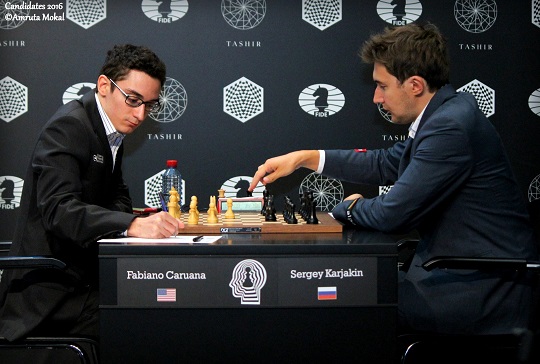
It was a fight between Fabiano Caruana’s excellent home preparation against Karjakin’s tenacity
It seems as if it is complete impossible to beat Sergey Karjakin in this tournament. Once again we saw the topical variation of the Queen’s Indian essayed by Karjakin with Ba6, Bb4-Be7 and d5 and we reached the following position.

Anish Giri had opted for 11.Ne5, Topalov went for 11.Rb1 and now Caruana played the move 11.a3. Apart from the obvious idea of playing b4, this move had a deeper point. Let’s have a look at what it was.

Although Karjakin didn’t play the move 14…Bf8, this position shows the point of White’s play. The rook can move to a2 and then to d2. And a2 is a much safer square than Topalov’s Rb2, which invited Black to go for Bd6. After 15.Ra2 Bd6 would simply lose to 16.Nxd5.
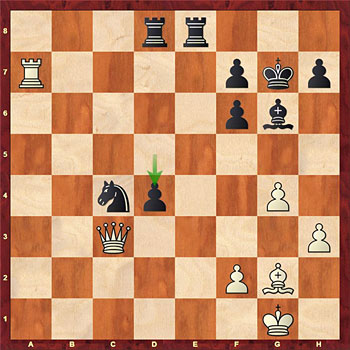
The move d5-d4 demonstrates what great form Karjakin is in. He sacrificed his c4 knight to push his d-pawn all the way down to the board. And he had calculated just about everything. Caruana could do nothing better than to accept the draw.

If Karjakin can defend such difficult positions his chances of winning the Candidates are really high

[Event "Candidates 2016"] [Site "?"] [Date "2016.03.17"] [Round "6"] [White "Caruana, Fabiano"] [Black "Karjakin, Sergey"] [Result "1/2-1/2"] [ECO "A00"] [WhiteElo "2794"] [BlackElo "2760"] [Annotator "Sagar Shah"] [PlyCount "72"] 1. d4 Nf6 2. c4 e6 3. Nf3 b6 4. g3 Ba6 5. b3 Bb4+ 6. Bd2 Be7 7. Nc3 d5 8. cxd5 exd5 9. Bg2 O-O 10. O-O Re8 11. a3 $5 {[%cal Ga2a3] While Topalov wanted to enforce b4 with the move Rb1, Caruana went for a3. But this move has a deeper point which is to use the safer square a2 to lift the rook rather than the b2 square.} c5 12. dxc5 bxc5 13. Ne5 Bb7 14. Bf4 Nbd7 (14... Bf8 {was played by Karjakin against Topalov, and when Topalov had responded with Rb2, the bishop came back to d6 as in many lines the rook was hanging on b2. Here Caruana can avoid all of that with the move Ra2!} 15. Ra2 $1 Bd6 $2 16. Nxd5 $1 $18) 15. Nc4 $5 (15. Nxf7 $6 Kxf7 16. Nxd5 Nxd5 17. Bxd5+ Bxd5 18. Qxd5+ Kf8 $15) 15... Nb6 16. Na5 Ba6 17. b4 $5 (17. Nc6 Qd7 18. Nxe7+ Qxe7 $11 {should be around equal.}) 17... cxb4 {This move was not expected by Caruana. It is really not the best, but to prove an advantage against it is not an easy task.} ({Better was} 17... Bd6) ({or} 17... Qd7) 18. axb4 Bxb4 19. Nc6 Bxc3 20. Nxd8 Bxe2 21. Qb3 (21. Qc2 {was also possible.} Bxa1 22. Rxa1 Raxd8 (22... Rexd8 23. Qxe2 $18 ) 23. Rxa7 $16) 21... Bxa1 22. Rxa1 Raxd8 {Karjakin didn't want to allow the manoeuvre Be5-d4 and hence took with this rook. But this means that the a7 pawn falls.} (22... Rexd8 23. Bc7 Rdc8 24. Bxb6 axb6 25. Rxa8 Rxa8 26. Bxd5 $16 ) 23. Rxa7 Nc4 {This is critical for assessing the quality of Karjakin's sacrifice. It must be said that over the board this position is not so easy to win for White. Black hardly has any weaknesses. The pawns are all on one side, which greatly reduces White's chances. Caruana tried hard but couldn't crack through Karjakin's defences.} 24. h3 Bh5 25. Bg5 Bg6 26. Bxf6 gxf6 27. g4 Kg7 28. Qc3 d4 $1 {This was truly a study-like finish by Karjakin. His defensive capabilities are truly fantastic.} 29. Qxc4 d3 30. g5 {This looks like the most natural way to force events, but better could have been} (30. Kh2 d2 31. Bf3 d1=Q 32. Bxd1 Rxd1 $16 {when White can keep trying. Whether he can win or not is a different question, but he has some chances.}) 30... d2 (30... fxg5 $2 31. Bd5 $1 d2 32. Qd4+ Kg8 33. Qxd2 $18) 31. gxf6+ Kh8 (31... Kxf6 32. Qc3+ Kg5 33. Bf3 {and the king on g5 doesn't really feel safe.} d1=Q+ 34. Bxd1 Rxd1+ 35. Kh2 Kh6 36. Qf6 Re6 37. Qf4+ Kg7 38. Rxf7+ Bxf7 39. Qg4+ Kf8 40. Qxd1 {and although White is up a lot of material this might well be a theoretical draw.}) 32. Bf3 Be4 $1 {A very strong move that had to be accurately calculated.} 33. Kh2 (33. Qxf7 $2 d1=Q+ (33... Rg8+ 34. Qg7+ Rxg7+ 35. fxg7+ Kg8 36. Bd1 $11) 34. Bxd1 Rxd1+ 35. Kh2 Rg8 36. Qxg8+ Kxg8 $19) (33. Bg4 Rg8 34. Ra1 d1=Q+ 35. Rxd1 Rxd1+ 36. Kh2 Bd5 $11) 33... Bd5 $1 34. Qg4 (34. Qh4 Rg8 $1 35. Rxf7 (35. Bxd5 d1=Q) 35... Bxf7 36. Be4 Bg6 37. f7 d1=Q 38. Qf6+ Rg7 39. f8=Q+ Rxf8 40. Qxf8+ Rg8 41. Qf6+ $11) 34... Rg8 35. Bd1 Rxg4 36. hxg4 h6 {A brilliant defensive effort by Sergey.} 1/2-1/2
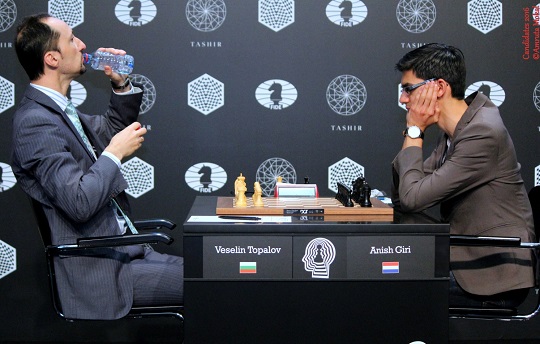
It is obvious that Topalov is having a tough time at this Candidates tournament. Being on –2
he has to indulge in wacky play to keep himself interested in the event. And he came up with…

All of opening theory is thrown out of the window once this move is made. While it is true that this move has been played only 27 times before, it has been played by GM Simon Williams in seven of his games. Can we call it the Williams’ line? An amazing co-incidence lies in the fact that the English GM has recorded an interactive video for ChessBase Magazine 171 which is due to release on 29th of March.
Have a sneak into the seven minute video to get an idea about the 3.h4 move
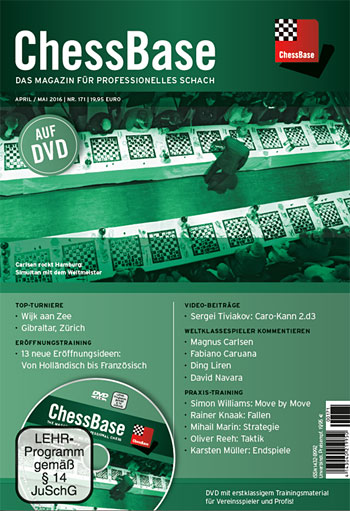
The ChessBase Magazine 171 will be available in the ChessBase
Shop on the 29th of March, but you can pre-order it here

The three white pawns on the fourth rank definitely are a great sight
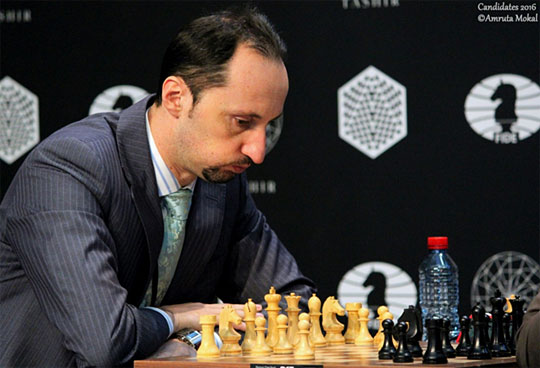
Topalov has switched to a daredevil mode in this tournament. He doesn’t really care
much about results – what he is looking for is an interesting game of chess.
A word from the horse’s mouth about why he chose the move 3.h4
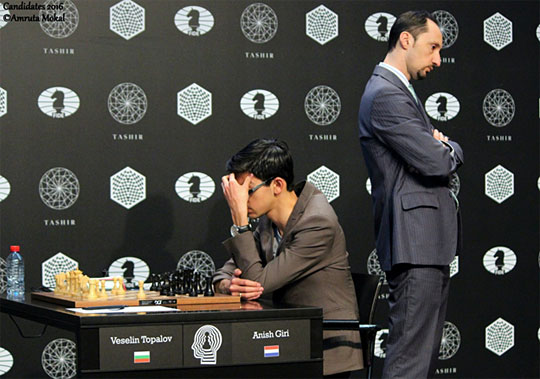
Giri’s solution: Topalov made his move 3.h4 and left the board for Anish to think.
The Dutch grandmaster did so for nearly ten minutes and replied with…

…the Benko Gambit!
Anish explains his thought process in choosing how to respond to 3.h4
The game was interesting. Topalov didn’t really get any advantage out of the opening. He could well have been worse. Anish had typical Benko-like compensation – he kept pressing and in the end was even a pawn up. But Topalov defended staunchly and made a draw.

[Event "Candidates 2016"] [Site "?"] [Date "2016.03.17"] [Round "6"] [White "Topalov, Veselin"] [Black "Giri, Anish"] [Result "1/2-1/2"] [ECO "A00"] [WhiteElo "2780"] [BlackElo "2793"] [Annotator "Sagar Shah"] [PlyCount "135"] 1. d4 Nf6 2. c4 g6 3. h4 $5 {[%cal Gh2h4]} (3. Nc3 d5 4. h4 {is not so great due to} c5 $1) 3... c5 (3... Bg7 4. Nc3 {is now a better version because Black cannot play the d5 followed by c5 line.}) (3... d5 $6 4. cxd5 Nxd5 5. e4 $14) 4. d5 b5 {As Anish explained, the Benko is a very sound opening, it is just that Black doesn't have the time in the opening to execute it well. But if White wastes time with 3.h4 then the same Benko Gambit can be employed.} 5. cxb5 a6 6. bxa6 Bg7 7. Nc3 O-O 8. e4 d6 9. Nf3 Qa5 {Anish had got the same position against Adrien Demuth a few months ago but with the pawn on h4. He managed to win that game. This explains why Anish was so positive about his position. The move h4 doesn't make much sense here.} 10. Bd2 Bxa6 11. Qc2 Nbd7 12. Ne2 $6 (12. Na4 $5 Bxf1 $5 (12... Qc7 13. Bxa6 Rxa6 14. O-O $14) 13. Bxa5 Bxg2 14. Nd2 Bxh1 15. Bc3 Bh6 {gives Black some compensation, but maybe it is not enough.}) 12... Qb6 13. Bc3 h5 $6 {A critical waste of time by Anish. He could have snatched the initiative without worrying about the h-file.} (13... Rfb8 $1 14. Ng3 Ng4 $1 15. h5 Bxc3+ 16. bxc3 Qb2 $17) 14. Ng3 Ng4 15. Bxg7 Kxg7 16. Bxa6 Qxa6 17. Ne2 Nge5 18. Nxe5 Nxe5 19. O-O Qd3 {This position is a dream for any Benko player, but objectively this should be around equal.} 20. Qxd3 ( 20. Rfc1 Rfb8 21. Nf4 Qxc2 22. Rxc2 Ra4 23. f3 f5 $1 $132) 20... Nxd3 21. b3 Rfb8 (21... Ra3 $5) 22. Rfd1 Ne5 23. f3 Ra3 24. Kh2 Rba8 25. Nc1 f5 26. exf5 gxf5 27. Rb1 Rb8 28. Rb2 Rb4 29. Kh3 c4 30. Re2 cxb3 31. Nxb3 Ng6 32. Kg3 Raa4 33. Red2 Kf6 34. Kf2 Rb5 {Black is surely the one who is pressing, in spite of being a pawn down, mainly because his pieces are more active and there are more targets to attack.} (34... Rxh4 35. Nd4 Ra5 $17) 35. Rh1 Rxh4 36. Rxh4 Nxh4 {White's task has eased a bit, due to the exchange of a pair of rooks, but there should still be some suffering.} 37. f4 Ng6 38. g3 h4 39. Rd3 hxg3+ 40. Kxg3 Nf8 41. Kf3 Nd7 42. a4 Rb4 43. a5 Nf8 $1 {Anish really liked this move transferring his knight to g6.} 44. Nd4 Ng6 45. a6 Ra4 46. Ne2 Rxa6 { And as is typical in Benko, from being a pawn down, Black is now a pawn up.} 47. Nd4 Nf8 48. Nc2 Nd7 49. Ne3 Ra2 50. Rd1 Rh2 51. Rg1 Rh3+ ({An interesting variation that Anish showed in the press conference went something like this} 51... Rh5 52. Rg3 Nf8 53. Rg1 Rh4 54. Rg5 $2 Rxf4+ $1 55. Kxf4 e5+ $3 $19) 52. Rg3 Rxg3+ 53. Kxg3 {Although Botvinnik said that knight endgames are like pawn endgames, this one cannot be won.} Nc5 54. Kf3 e6 55. dxe6 Kxe6 56. Nc2 Kd5 57. Ne3+ Ke6 58. Nc2 Nb3 59. Ne3 Nd4+ 60. Kf2 Nc6 61. Ke2 Nb4 62. Kd2 Nd5 63. Ng2 Ne7 64. Kd3 Nc6 65. Nh4 Nb4+ 66. Kd4 Nc6+ 67. Kc4 Nb8 68. Nxf5 $1 {and the game ends in an instant draw.} (68. Nxf5 Kxf5 69. Kd5 $11) 1/2-1/2
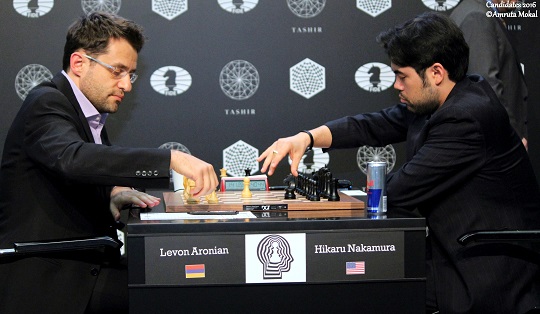
The game between Aronian and Nakamura was the last one to end on this day. The opening and the middlegame were surely quite interesting, but the real action was in the endgame. Nakamura was defending an inferior endgame for quite some time and looked well within the reach of a draw. The following position was reached after move 74.

Nakamura (Black) is on the move here. Hikaru thought for a while and brought his hand down on the board, very clearly touching his king with the intention to move it. At that moment he realized what a grave blunder it would be to give up the f6 square especially because Ra6+ can be met with Rd6. Hence, with his hand on the king he said “J’adoube.” This was of course unfair as he clearly wanted to move the king. Aronian lifted his hands in the air in protest and called the arbiter. Hikaru Nakamura without any argument moved his king to f8 and after Kf6 duly lost the game.
This two minute video shows exactly what transpired
The American grandmaster is having a dismal tournament with two losses and now this j’adoube controversy. Maybe we should all go easy on him as the pressure of competition often makes people do things involuntarily. However what will surely not go well with the organizers is Hikaru’s behavior after the game. He left the playing hall in a hurry, clearly not wanting to wait for the press conference. It was the first time in this event that both the players were not present at a press conference after the game. In doing so he flouted two FIDE regulations for the Candidates:
3.11.1. If a player fails to appear at the Players' Meeting, the Opening or Closing Ceremony or any approved function of the Championship such as official receptions, press conferences or interviews, or conducts himself in a manner contrary to the spirit of sportsmanship or the FIDE Code of Ethics, then he shall suffer the following penalty: 5% of his prize money shall be forfeited to the Organisers and a further 5% to FIDE for each breach. In cases of serious misconduct the player may be disqualified from the event and the World Chess Championship cycle.
3.12.2. All players are required to make themselves available for post-game press conferences, of not more than 20 minutes duration, immediately after the game. All winners and medalists are obliged to attend the final press conference after the event has ended and to provide an exclusive interview for the FIDE website, if requested by the FIDE Press Officer. Players violating these rules will be subjected to the penalties mentioned in the event regulations.
We will have to wait and watch what actions will be taken against Nakamura for not attending the post-game conference.
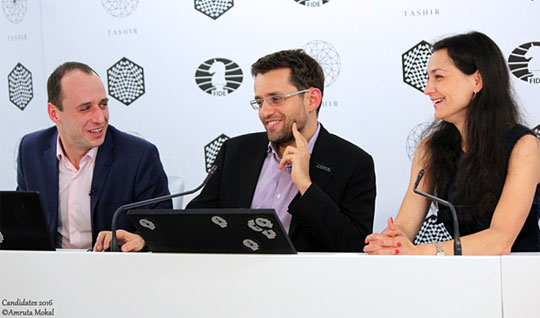
As Nakamura didn’t arrive to the press conference it was Aronian talking to Kosteniuk and Miroshnichenko. One of the questions posed to Aronian was whether the endgame was winning if Nakamura had not played Kf8.

Aronian was quite confident that this endgame was winning for White. In his element he made the press conference extremely entertaining as he jokingly behaved like a teacher who was showing the method to win this endgame to his students. As Levon said on numerous occasions, even he wasn’t 100% sure about the winning method, he was sure that the position was winning. Watch him explain the intricacies of this endgame in the video below:
You can watch the entire press conference or you can
skip to the relevant endgame part which begins at around five minutes.
The funny thing is that the position is not winning. Black can hold on with accurate play. Here is my analysis:

[Event "Candidates 2016"] [Site "?"] [Date "2016.03.17"] [Round "6"] [White "Aronian, Levon"] [Black "Nakamura, Hikaru"] [Result "1-0"] [ECO "E15"] [WhiteElo "2786"] [BlackElo "2790"] [Annotator "Sagar Shah"] [PlyCount "166"] 1. d4 Nf6 2. c4 e6 3. Nf3 b6 4. g3 Ba6 5. Qc2 c5 6. d5 exd5 7. cxd5 Bb7 8. Bg2 Nxd5 9. O-O Nc6 10. Rd1 Be7 11. Qa4 Nf6 12. Nh4 O-O 13. Nc3 $146 {A new move by Aronian. Previously only Nf5 had been played.} g6 14. Bg5 Rb8 {Here Aronian's opening knowledge came to an end.} 15. Bf4 $5 Rc8 16. Bh6 {The idea with this Bg5-f4-h6 is to lure the rook to c8 before bringing the queen to f4 so that Qb8 is not possible.} Re8 17. Qf4 Na5 (17... Nh5 {was definitely what Levon was waiting for.} 18. Qxf7+ $1 Kxf7 19. Bd5+ Kf6 20. Ne4+ Ke5 21. f4+ Nxf4 22. gxf4#) 18. Nf5 (18. Bxb7 Nxb7 19. Nf5 Bf8) 18... Bxg2 (18... Bf8 19. Bxf8 Rxf8 20. Nd6 $16) 19. Nxe7+ $6 (19. Kxg2 {was better according to Levon.}) 19... Qxe7 20. Kxg2 Qe5 21. e3 d5 22. Bg5 Ne4 $6 (22... Kg7 $11) 23. Rxd5 Qxf4 24. gxf4 Nxc3 25. bxc3 {Around here Aronian was pleased with his position. He has the open d-file in his control and a more active king. This should mean something.} Kg7 26. Rd7 h6 27. Be7 Nc4 28. Rad1 a5 29. R1d5 Rc6 30. Ra7 Re6 31. Rdd7 Kg8 32. h4 Kg7 33. Bd8 Kg8 34. Be7 Kg7 35. Rab7 Kg8 36. Rbc7 Na3 37. Bd8 Nc4 38. Be7 Na3 39. Rb7 Nc4 40. Kf3 a4 41. Rbc7 Nd2+ 42. Rxd2 R6xe7 43. Rc6 Re6 44. Rxe6 Rxe6 45. c4 {White has a small edge but Black can hold with accurate play.} Kg7 46. e4 Re8 47. e5 Rb8 48. Rd7 Kf8 49. f5 gxf5 50. Kf4 b5 51. cxb5 Rxb5 52. Kxf5 a3 (52... Ke8 53. Rc7 (53. Ra7 c4 {and Black has better drawing chances.}) 53... Rb2 54. f4 Rxa2 55. Kf6 $18) 53. f4 $6 (53. Kf6 $1 Rb6+ 54. Rd6 $18 Rb8 (54... Rxd6+ 55. exd6 {The pawn ending is just lost.}) 55. f4 $18 Rc8 56. f5 c4 57. Rd7 c3 58. Rxf7+ Ke8 59. e6 c2 60. Rh7 $18) 53... Rb4 54. Ra7 c4 55. Rxa3 Rb2 56. Ra6 Kg7 57. a4 c3 58. Ra7 c2 59. Rc7 Rb4 60. a5 Ra4 61. Rxc2 Rxa5 {This is the endgame position which Aronian thinks that he was winning even if Nakamura didn't blunder. In the game he moved around a bit with his pieces. In the analysis he began with h5 as the right way for White to proceed.} 62. Rc4 (62. h5 Rb5 63. Rc8 Ra5 64. Rd8 Ra4 65. Kg4 Rb4 66. Kf3 { [%cal Gf4f5] This is all still main line of the analysis. According to Levon White threatens f5 here and it is a deadly idea.} Rb3+ 67. Ke4 {And now Kosteniuk played Rb1. Instead Rh3 can be a strong move.} Rb1 {Even this is not so clear as after} (67... Rh3 $1 68. f5 Rh4+ 69. Kd5 Rxh5 70. f6+ Kg6 $11) 68. Rd7 Rb4+ (68... Rb5) 69. Rd4 Rb1 70. f5 {Aronian felt that this position is winning, but after} Re1+ 71. Kd5 Rf1 72. f6+ Kf8 73. Kc6 Ke8 74. Rb4 Rc1+ 75. Kd5 Rd1+ 76. Rd4 Rc1 $11 {It is just a draw.}) 62... Ra1 63. Rc7 Kf8 {is not yet a mistake because Kf6 is met with Ra6+ and there is no Rd6 yet.} ({Also possible was} 63... Ra4 64. e6 Ra5+ 65. Ke4 Ra4+ 66. Kf3 Kf6 67. exf7 (67. e7 Ra8 $11) 67... Kg7 $11) 64. Rd7 Ra4 65. Rd3 Rc4 66. Re3 Ke7 67. Re4 Rc1 68. Rb4 Kf8 69. Rb6 Kg7 70. Rb7 Kf8 71. Rb8+ Kg7 72. Rb4 Ra1 73. Rd4 Ra2 74. Rd7 Kf8 $4 {Nakamura made this move and this led to the j'adoube controversy. Maybe Naka didn't realise that Kf6 Ra6+ can now be met with Rd6. When he touched the king he must have realized it. Or else he could have just played Ra4.} (74... Ra4 75. Rd8 (75. e6 Ra5+ 76. Ke4 Ra4+ 77. Ke3 Kf6 $1 $11) 75... Rb4 76. h5 Ra4 77. Kg4 Rb4 78. Kf3 Rb1 79. Ke4 Re1+ 80. Kf5 Rh1 $11) 75. Kf6 {Now it is all over.} Ra6+ 76. Rd6 Ra8 77. h5 Kg8 78. f5 Rb8 79. Rd7 Rb6+ 80. Ke7 Rb5 81. Rd8+ Kh7 82. Kf6 Rb6+ 83. Rd6 (83. Kxf7 Rf6+ 84. Ke8 Rxf5 85. e6 $18) 83... Rb7 { Nakamura made this move and resigned. e6 followed by e7 just wins.} 1-0
Aronian confidently saying that his position was winning when actually it was not, and Nakamura’s j’adoube incident led to a pretty angry Facebook post by ACP President Emil Sutovsky:
“I am sorry, but Aronian pretending this endgame to be winning left me speechless. I put it mildly. This sounds like complete rubbish. The plan he claimed to "know" and to be "simply winning" just doesn't work and has more than one refutation. Top player is not supposed to mislead hundreds of thousands people this way. Also the way Levon conveyed his "knowledge" was quite shocking. But still less shocking than Nakamura trying to j'adoube his king after he started making the move. The players must be really under severe pressure in this event. Sorry I have to write it instead of praising Anand or singling out Karjakin's brilliant defence. But I really believe that being a top player means a highest responsibility towards the entire Chess World.”

What do you do when the tension of watching the games becomes too much? You start playing!
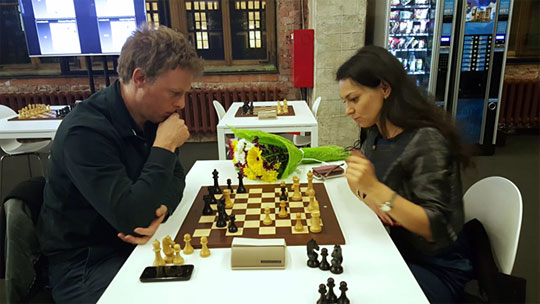
Sixth round was the last day of Alexandra Kosteniuk’s role as a commentator.
She ended it with a blitz game against her husband Pavel Tregubov!
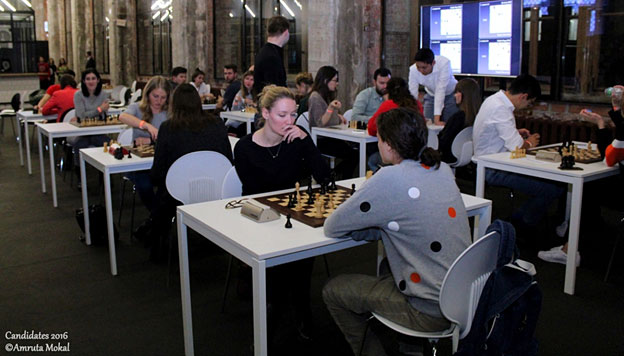
Even at ten at night there were a lot of youngsters playing against each other
on the chess sets set up in the tournament hall
All pictures by Amruta Mokal of ChessBase India
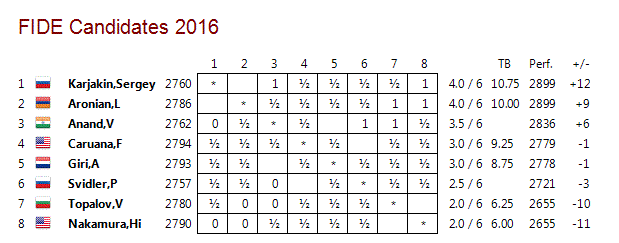
|
|
|||||||||||||||||||||||||||||||||||||||||||||||||||||||||||||||||||||||||||||||||||||||||||||||||||||||||||||||||||||||||||||||||||||||||||||||||||||||||||||||||||||||||||||||||||||||||||||||||||||||||||||||||||||||||||||||
ChessBase is doing roundup shows at the end of each round of the Candidates.
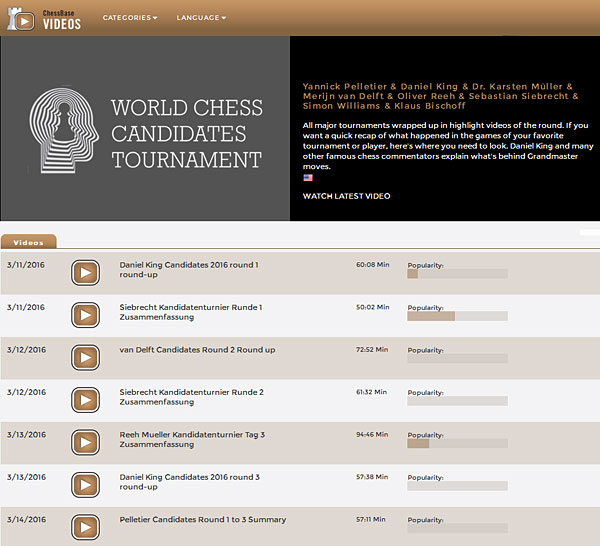
Here is the full schedule of future broadcasts – you need to be a premium member to watch

| Date | Day | Round | English | German |
| 18.03.2016 | Friday | Free day | Summary Yannick Pelletier | |
| 19.03.2016 | Saturday | Round 7 | Oliver Reeh/Karsten Müller | Klaus Bischoff |
| 20.03.2016 | Sunday | Round 8 | Chris Ward | Klaus Bischoff |
| 21.03.2016 | Monday | Round 9 | Simon Williams | Klaus Bischoff |
| 22.03.2016 | Tuesday | Free day | Summary Yannick Pelletier | |
| 23.03.2016 | Wednesday | Round 10 | Daniel King | Klaus Bischoff |
| 24.03.2016 | Thursday | Round 11 | Simon Williams | Klaus Bischoff |
| 25.03.2016 | Friday | Round 12 | Daniel King | Oliver Reeh/Karsten Müller |
| 26.03.2016 | Saturday | Free day | Summary Yannick Pelletier | |
| 27.03.2016 | Sunday | Round 13 | Daniel King | Klaus Bischoff |
| 28.03.2016 | Monday | Round 14 | Yannick Pelletier | Klaus Bischoff |